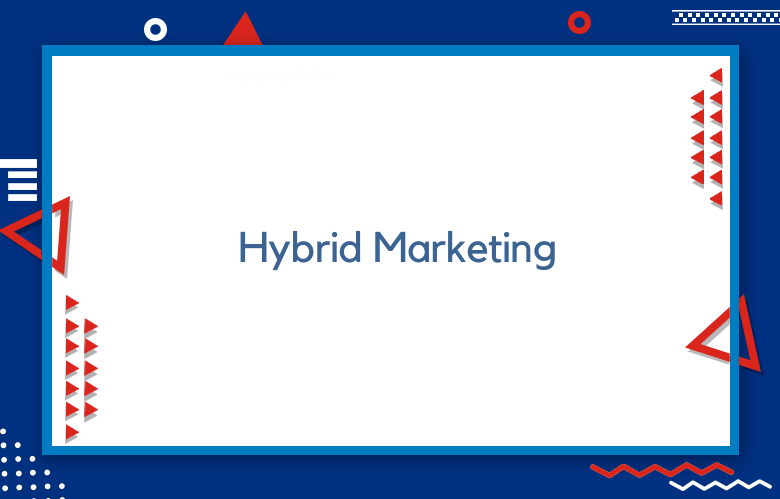What is Hybrid Marketing, and Why does Your Business Need It?

Traditional advertising methods have existed long enough that almost everyone is familiar with them. But what about hybrid marketing? Hybrid marketing combines traditional, digital, and interactive marketing tactics to create a practical approach to promoting your business. Let’s explore why hybrid marketing is so vital to the success of your business.
Hybrid marketing is a term used to describe the combination of traditional and digital marketing strategies used to reach potential customers.
Digital marketing can be powerful, but it often needs a more personal touch than traditional marketing methods offer.
With hybrid marketing, you can use both approaches to create an effective strategy for reaching your target audience. Let’s look at why hybrid marketing is essential for your business.
Maximizing Your Reach: Combining Traditional and Digital Marketing with Hybrid Marketing?
Hybrid marketing is an innovative marketing approach that combines traditional and digital platforms to maximize reach.
Traditional marketing includes television, radio, print publications such as newspapers or magazines, and out-of-home advertising such as billboards.
Digital marketing includes social media, search engine optimization (SEO), email campaigns, website development, and more.
Hybrid marketers use traditional and digital outlets to get the most impact from their campaigns.
One advantage of hybrid marketing is that it allows a broader range of target audiences to be reached simultaneously.
For instance, a marketer with a limited budget might combine television ads with online banner ads to achieve a broader audience than either type of advertising could do on its own.
It also increases the effectiveness of each campaign by reaching multiple audiences with one message or advertisement.
Using both traditional and digital media allows for better tracking and measurement of results, which helps marketers refine their strategies for better success in the Future.
Creating a Successful Hybrid Marketing Strategy: Tips and Best Practices?
Define Your Goals
Defining your goals is the first step in creating a successful hybrid marketing strategy. What are you hoping to achieve with your marketing efforts? Do you want to increase brand awareness, drive website traffic, or generate leads?
Once you clearly understand your goals, you can develop a plan to help you achieve them.
Research Your Audience
Before developing an effective marketing strategy, you need to understand your target audience clearly. Who are they?
What are their needs and wants? What are their pain points? By taking the time to research your audience, you can develop messaging and strategies that will resonate with them.
Develop a Content Strategy
Content is one of the essential elements of a successful hybrid marketing strategy.
Your content should be informative, engaging, and relevant to your audience.
It should also be optimized for search engines so people can easily find it when looking for information on the topics you cover.
Create a Social Media Plan
Social media is a powerful tool that helps you reach many people with your message.
However, it’s essential to create a social media plan that outlines what platforms you’ll use, what kind of content you’ll share, and how often you’ll post.
Without a plan, it’s easy to get overwhelmed or lost in the sea of social media noise.
Invest in Paid Advertising
Paid advertising is another effective way to reach your target audience with your message.
When done correctly, paid ads can drive website traffic and generate leads.
However, it’s essential to work with an experienced agency or marketer who understands how to create ad campaigns that are effective and efficient with your budget.
Analyze Your Data Regularly
Data is essential for understanding whether or not your hybrid marketing strategy works.
Track key metrics such as website traffic, leads generated, and conversions to see what’s working and where there may be room for improvement.
Remember to A/B test different elements of your campaigns so that you can further optimize their effectiveness.
Be Prepared to Adjust the Course
Even the best-laid plans sometimes need to be adjusted based on new information or changes in the marketplace. Be prepared to make changes to your hybrid marketing strategy as needed so that you can continue achieving your desired results.
The Role of Content Marketing in Hybrid Marketing: Engaging with Customers Across Channels?
Content marketing is essential to hybrid marketing, which seeks to engage customers across multiple channels.
It allows businesses to reach customers through various mediums, including social media platforms, search engine optimization (SEO), email marketing, and more.
Content marketing helps brands build customer relationships by delivering relevant, timely content that encourages engagement and loyalty.
Content can take various forms, such as informative, interactive infographics, instructional videos, creative graphics, or helpful e-books.
Through content marketing strategies, businesses can provide their customers with exciting and valuable information that they can use to make informed decisions.
This helps establish trust by allowing customers to learn more about the brand and its offerings.
Companies can connect with their target audience meaningfully by providing quality content across multiple channels.
Leveraging Social Media in Hybrid Marketing: Best Practices and Case Studies?
Define Your Goals
The first step is to define your goals for using social media in your hybrid marketing strategy. What do you hope to achieve?
Are you looking to increase brand awareness, drive traffic to your website, or generate leads? Once you have a clear idea of your goals, you can develop a plan for using social media to achieve them.
Research Your Audience
You must understand your target audience and their interests before using social media.
This will help you determine which platforms to use and what content to share.
You can use demographic information such as age, gender, location, and interests to narrow down your target audience.
Select the Right Platform
Once you know your target audience, you must select the right platform or platforms to reach them.
Various social media platforms are available, each with unique features and a user base.
For example, if you’re looking to reach millennials, Instagram would be a good choice, whereas LinkedIn would be a better option if you want to get business professionals.
Create Compelling Content
Once you’ve selected the right platform or platforms for your hybrid marketing strategy, it’s time to start creating compelling content that will resonate with your target audience.
Your content should be informative, engaging, and visually appealing. Remember to include calls to action (CTAs) so your audience knows what you want them to do next.
Promote Your Content
Once you have created some great content, it’s time to start promoting it! There are several ways you can upgrade your content,
Such as through paid advertising, social media influencers, or organic methods like SEO and content marketing.
Analyze and Adjust
After implementing your hybrid marketing strategy for a while, it’s crucial to analyze the results and adjust as needed.
What’s working well? What could be improved? What goals have you achieved? Be sure to continue monitoring your results to fine-tune your strategy over time.
Be Patient
Hybrid marketing takes time and effort to be successful. Don’t expect immediate results;
Focus on long-term success by consistently creating great content and promoting it effectively. If you stay patient and dedicated, you will eventually see the fruits of your labor pay off!
Integrating Email Marketing into Your Hybrid Marketing Strategy: Insights and Recommendations?
Email marketing should be an integral part of any hybrid marketing strategy. It offers tremendous potential to reach consumers, build relationships, and generate revenue.
Here are some insights and recommendations for integrating email marketing into your hybrid marketing strategy:
Identify Your Target Audience
Using an email list segmentation tool, identify the demographics of your target audience and craft messages that will resonate with them.
Consider using customer data such as purchase history, interests, and preferences to personalize emails further.
Craft Compelling Content
Create engaging emails that encourage readers to take action. Include compelling subject lines and clear calls-to-action that entice people to click through to your website or social media page.
Also, consider including incentives such as discounts or exclusive offers in the body of the email.
Leverage Automation Tools
Automate the delivery of emails by utilizing tools such as triggered sends, which send out emails when customers perform specific actions (such as making a purchase).
Also, consider developing drip campaigns to ensure timely. Relevant content is being sent out regularly.
Monitor Performance Metrics
Analyze all email campaigns and measure performance metrics such as open rates, click-through rates, unsubscribe rates, etc.
This information can help you refine your messaging strategies and better target audiences.
The Benefits of Hybrid Marketing for Small Businesses: A Comprehensive Guide?
Cost Efficiency
One of the most significant advantages of hybrid marketing is its cost-effectiveness.
Traditional advertising can be costly, especially regarding television or radio commercials, print ads, and even direct mail campaigns.
With hybrid marketing, you can combine traditional and digital tactics without breaking the bank. This allows you to focus your efforts on specific channels that will yield the best results for your business.
Flexibility & Scalability
Hybrid marketing is also much more flexible than traditional advertising methods because it allows you to adjust your campaigns based on their performance.
This flexibility will enable you to tailor your message and budget accordingly to maximize impact and ROI at any given time.
Hybrid marketing can be easily scaled up or down depending on market conditions, making it an excellent choice for small businesses with limited budgets who want to remain competitive.
Reach & Engagement
With hybrid marketing, small businesses have access to multiple channels that can be used to reach potential customers both online and offline.
By leveraging data-driven insights from various platforms, such as social media analytics or web tracking tools, companies can identify what works best for their target audience and deliver messages that resonate with them to build long-term customer relationships.
This approach also helps foster greater engagement with customers as they feel they’re being heard by brands that better understand their needs or interests.
Increased Visibility
Another significant benefit of hybrid marketing is increased visibility for your business across all online and offline channels due to increased targeted messaging capabilities enabled by data-driven insights.
They are gathered from multiple sources, including search engine algorithms and consumer behavior analysis tools like Google Analytics or Facebook Insights.
With this knowledge, companies can craft messages explicitly tailored toward each channel, resulting in a more cohesive brand presence across all platforms and greater recognition from potential customers.
Maximizing ROI with Hybrid Marketing: Key Metrics to Measure and Analyze?
Maximizing ROI with Hybrid Marketing requires understanding the key metrics to measure and analyze to track performance effectively.
Monitoring and evaluating how each channel contributes to the overall marketing objective will enable businesses to achieve their desired results.
Critical metrics for assessing hybrid marketing performance include cost per acquisition (CPA), customer lifetime value (LTV), return on ad spend (ROAS), and engagement rate. CPA looks at the cost of acquiring a new customer or user on a platform.
In contrast, LTV looks at the overall profit accumulated by a customer over an extended period.
ROAS is the ratio of revenue a campaign generates compared to its cost. At the same time, the engagement rate indicates how users interact with content across all channels.
The Role of Data-Driven Decision Making in Hybrid Marketing: Insights and Examples?
Data-driven decision-making has become essential for organizations that want to stand out from the competition in today’s dynamic and highly competitive digital marketing landscape.
Hybrid marketing combines traditional and online marketing strategies, using data to inform decisions to optimize resources.
Using analytics to drive decisions gives marketers valuable insights into customer behavior, allowing them to understand what motivates customers and target their efforts accordingly.
Marketers can quickly identify the most effective strategies by tracking customer responses to campaigns and adjusting their approach as needed.
This allows them to create targeted campaigns that engage customers more effectively while saving time and money by eliminating waste.
Trends and Predictions in Hybrid Marketing: What to Expect in the Future?
Hybrid marketing is becoming increasingly important as businesses look to capitalize on the best of digital and traditional marketing strategies.
Technological advances allow combining digital, social, and other channels to create innovative and effective campaigns that reach customers across multiple platforms.
One key trend in the Future will be a greater emphasis on data-driven marketing.
Businesses have access to more information about their customers, enabling them to tailor their hybrid strategies for maximum impact.
For example, companies can use customer data to determine how to target audiences with personalized offers or messages.
This targeted approach can help companies reach their desired audiences more effectively and efficiently.
Conclusion
Hybrid marketing is quickly becoming one of the most popular strategies for businesses looking to increase their presence online while also building solid relationships with their local communities through traditional methods like print ads or radio spots.
Not only does it allow businesses to experiment with different types of content without breaking the bank, but it also provides an effective way to target specific audiences while increasing overall brand awareness and engagement across multiple channels.
So, if you’re looking for a comprehensive approach that produces results faster than ever, hybrid marketing might be the answer!
If you’re looking for an effective way to increase visibility for your business and expand its reach across multiple channels, then investing in a well-crafted hybrid marketing campaign is what you need!
Call: +91 9848321284
Email: [email protected]



